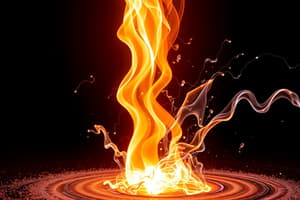Podcast
Questions and Answers
Which form of energy is dependent on an object's mass and velocity?
Which form of energy is dependent on an object's mass and velocity?
- Chemical energy
- Thermal energy
- Potential energy
- Kinetic energy (correct)
Which type of energy is stored in the bonds between atoms?
Which type of energy is stored in the bonds between atoms?
- Chemical energy (correct)
- Nuclear energy
- Electrical energy
- Radiant energy
What happens to gravitational potential energy as an object's height increases?
What happens to gravitational potential energy as an object's height increases?
- It remains constant.
- It increases. (correct)
- It becomes kinetic energy.
- It decreases.
Which of the following is a characteristic of thermal energy?
Which of the following is a characteristic of thermal energy?
What form of energy involves the movement of electrons?
What form of energy involves the movement of electrons?
Which type of energy travels as waves?
Which type of energy travels as waves?
What type of potential energy is stored in deformed elastic objects?
What type of potential energy is stored in deformed elastic objects?
Which of the following examples illustrates sound energy?
Which of the following examples illustrates sound energy?
Flashcards
Kinetic Energy
Kinetic Energy
Energy of motion
Potential Energy
Potential Energy
Stored energy due to position or shape
Gravitational Potential Energy
Gravitational Potential Energy
Stored energy due to height in gravity
Elastic Potential Energy
Elastic Potential Energy
Signup and view all the flashcards
Thermal Energy
Thermal Energy
Signup and view all the flashcards
Chemical Energy
Chemical Energy
Signup and view all the flashcards
Electrical Energy
Electrical Energy
Signup and view all the flashcards
Radiant Energy
Radiant Energy
Signup and view all the flashcards
Nuclear Energy
Nuclear Energy
Signup and view all the flashcards
Sound Energy
Sound Energy
Signup and view all the flashcards
Study Notes
Introduction to Energy Types
- Energy is the capacity to do work or cause change. It exists in various forms, and can be transformed from one form to another.
- Understanding different forms of energy is crucial in fields such as physics, engineering, and everyday life.
Kinetic Energy
- Kinetic energy (KE) is the energy of motion.
- The amount of KE depends on an object's mass and velocity.
- The formula for kinetic energy is KE = 1/2 * m * v^2, where 'm' is mass and 'v' is velocity.
- Examples include a moving car, a flowing river, and a spinning top.
Potential Energy
- Potential energy (PE) is the stored energy an object possesses due to its position or configuration.
- Gravitational potential energy is energy an object has due to its position in a gravitational field.
- Examples include a book on a shelf, a stretched rubber band. The higher the object, the more gravitational potential energy.
- Elastic potential energy is stored in a deformed elastic object.
- Examples include a stretched spring, a bowstring drawn back.
Thermal Energy
- Thermal energy is the internal energy of an object due to the motion of its particles.
- Higher temperature means more thermal energy.
- Heat transfer occurs when thermal energy moves between objects at different temperatures.
- Examples include heat from a stove burner, body temperature.
Chemical Energy
- Chemical energy is stored in the bonds between atoms in molecules.
- When these bonds are broken, energy is released.
- Examples include fuels like gasoline, batteries, food.
- Photosynthesis is a process that converts light energy into chemical energy.
Electrical Energy
- Electrical energy is the energy associated with the movement of electrons.
- It is carried by electric currents.
- Examples include energy from power outlets, lightning, batteries powering devices.
Radiant Energy
- Radiant energy, also known as electromagnetic energy, is energy that travels as waves.
- This includes visible light, ultraviolet rays, infrared radiation, X-rays, and radio waves.
- Examples include sunlight, heat from a fire, energy from a lamp.
Nuclear Energy
- Nuclear energy is energy stored within the nucleus of an atom.
- It is released during nuclear reactions, like fission and fusion.
- Examples include energy from nuclear power plants, the sun's energy (fusion).
Sound Energy
- Sound energy is the energy carried by sound waves.
- These waves are created by vibrating objects.
- Examples include music from a speaker, human speech.
Other Forms (Brief Overview)
- Mechanical energy: The sum of kinetic and potential energy in a mechanical system.
- Biomass energy: Energy stored in organic matter, like wood and crops.
- Geothermal energy: Energy from the Earth's internal heat.
- Hydropower: Energy harnessed from the movement of water.
- Wind energy: Energy harnessed from the movement of air.
- Solar energy: Energy from the sun (a subset of radiant energy but often treated separately).
Studying That Suits You
Use AI to generate personalized quizzes and flashcards to suit your learning preferences.




